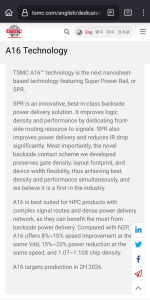I think you are misinterpretating TSMC/AMD timeline there ain't no way AMD gets first access to TSMC before Apple TSMC Says 2H26 for A16 meaning at least 2H27 for AMD to get anything for 2nm it is 25 so 2H 26 for AMD regarding yield only time knows the answer not even Intel/TSMC/AMD also for 18A we have to see if Intel 3 is anything to go by it is the only node in the last decade to be on time from Intel
Did you actually read what you posted?
"
A16 is best suited for HPC products with complex signal routes and dense power delivery networks, as these can benefit the most from backside power delivery".
What they don't say is that there's also quite a big cost premium for A16 -- and yes, I've actually had discussions with TSMC about all this instead of just reading press releases or what's posted on the web.
For all those reasons it's unlikely that A16 is a good fit for Apple mobile CPUs, it's much more likely to be used by Nvidia and AMD (when -- 2H26?) -- and maybe even Intel, if Intel Foundry can't deliver 18A as promised... ;-)
(where "delivered" means "in high volumes with good yield and competitive cost", not the meaning Intel (mis)used for 10nm)
And that's the kicker for Intel, not any theoretical dates about "process availability". If I was a betting man I'd put my money on A16 having more customers in much bigger volume sooner than Intel CPUs in Intel 18A -- and that's the measure of success for a foundry, not "I got there first!"...

Don't forget that A16 is pretty much the transistors from N2/N2P (which Apple certainly *will* use) with BSPD added on
for HPC applications -- and as a consequence a completely new set of IP is needed, which makes it less attractive for anyone who has already done N2 developments (e.g. Apple). My guess is that Apple will use N2/N2P and then N2X (all topside power), and then switch to BSPD for A14 by which time the cost penalty will also have come down since A16 will have pipecleaned the technology.
BSPD is in a very similar situation to when TSMC introduced EUV initially in N7+ before going all-in on N5 -- the technology change meant N7+ layouts were incompatible with N7 (and N7+ cost more) so new IP was needed and it got very few users, but it enabled TSMC to get the kinks out of EUV and then bring the cost down and volume up for N5.

